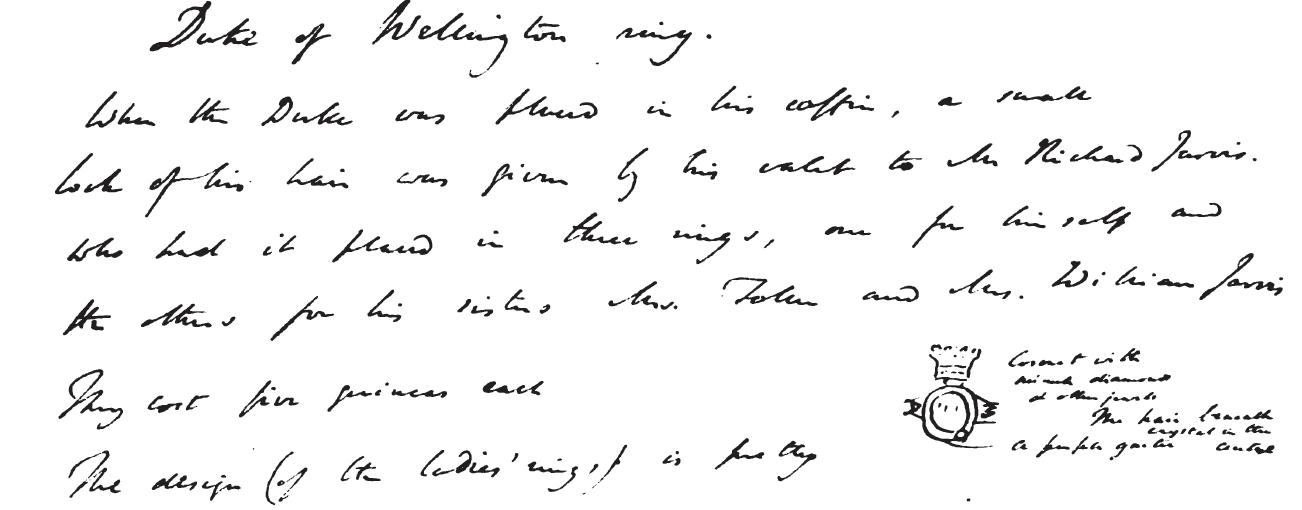Three Wellingtons To Rule Them All and Hair Jewellery July 2, 2014
Author: Beach Combing | in : Modern , trackback
I came across this story while looking into the history of magic rings. It is some, shall we say, marginalia, written into the back of a volume that was subsequently scanned by Google. This is not the first time I’ve come across an intriguing reference on an online scan, but this one begged more research. I read it as follows:
Duke of Wellington Ring. When the Duke was placed in his coffin, a small lock of his hair was given [?] by his valet to Mr Richard Jarvis who had it placed in three rings, one for himself and the other for his sister Mrs ??? [Toben?] and Mrs William Jarvis. They cost five guineas each. The design (of the ladies’ ring) is ??? Coronet [?] with and [???] diamonds and other jewels. His [???] hair beneath crystal in the [????] central [??]

Wellington died on 14 Sept 1852. There is no easy record of (i) rings associated with his death, or (ii) a Mr Richard Jarvis associated with Wellington. However, hair collecting was a nineteenth-century sport. We know, for example, that Queen Victoria asked for some of Wellington’s hair for her hair lock collection. Wellington’s manservant (his valet) apologised to HRH for the small quantity he sent but families and friends were clamouring for tufts of their own (Longford, Wellington, 400). It is irresistible to think of poor old Wellington, who had a marvellous head of hair in life, crossing the Styx clutching at his bald scalp. Hair of the Duke was even sold in the Times’ classifieds: we are back to a medieval cult of relics with about as much proof of provenance.
Another question that I’ve not been able to resolve is what precisely was done with the hairs. They were put into the ring. But what does that mean? Were they burnt into the gold or, if I’ve deciphered the rather handwriting, were they placed into something glass, perhaps as part of the coronet on top of the ring? I was sceptical about that until I read the following small ad in a London newspaper from 1852, the year of the great man’s death.
Dewdney, Artist in Hair, As hair jewellery will be chiefly worn this season [wth?!?!], Dewdney begs to announce to ladies wishing to preserve the hair of a relative or friend, that he has just completed an elegant assortment of pattern specimens of BRACELETS, Broaches, Chains, Rings, etc, richly mounted in beet gold. Charges most moderate.
So where are the rings? Drbeachcombing AT yahoo DOT com And any other hair jewellery doing the rounds?
2 July 2014: Invisible writes ‘How convenient you asked about hair jewelry! Just received in the mail today a copy of In Death Lamented: The Tradition of Anglo-American Mourning Jewelry by Sarah Nehama and Anne E. Bentley, which will tell you ALL about hair jewelry. The hair could be arranged as a lock under crystal, woven in a pattern like a basket-weave, or fashioned into delicate pictures. Sometimes chopped hair was mixed with paint and used to paint miniatures. Hair was used in both mourning and in sentimental jewelry. See these examples: (1), (2), (3 the foliage is almost all hair), (4), (5). You could send your hair or your loved one’s hair away to be fashioned into jewelry. There was always an uneasiness that you might not get back the original hair, but some spurious foreign substitute. Hair was also fashioned into watch chains, necklaces, and hair wreaths, often framed in a shadowbox (rather nasty, in my opinion–they are worked on wire and quiver like big hairy tarantulas) and you could take courses or get instructional books on how to do it yourself. There was rather a cult of making hair jewelry, pictures, or wreaths out of as many people’s hair as possible–such as this one: ‘Hair Wreath of Ten Thousand Locks. Miss Hattie Chipps, of Budds Lake, N.J., once made a wreath (which she still has in her possession) wholly of human hair. It comprises 10,000 locks from as many different heads, and is arranged in curious and beautiful designs, principally leaves, flowers, etc. She spent over a year in collecting the hair, which is of every shade and color, before the wreath itself was begun. It is a unique ornament as well as a triumph of patience and ingenuity. St. Louis Republic Trenton [NJ] Evening Times 13 August 1892: p. 2 People still do hairwork today. See http://www.hairworksociety.org/ There is also a museum and a Victorian Hair Workers organization. The Wellington ring sounds like a rather typical commemorative mourning ring for a public figure. Similar items were made for Lord Nelson and members of royal houses. Here’s a selection of mourning jewelry, including some hair pieces, and a ring without hair for Wellington. His funeral was such an immense event that it generated a great many souvenirs. I’ll finish with this Wellington mourning brooch, on a superb site that is essential if you want to understand hair jewelry: The Art of Mourning.’ Thanks Invisible!



